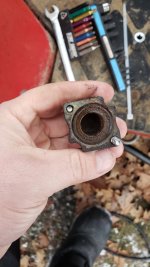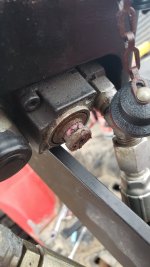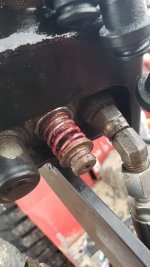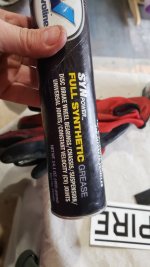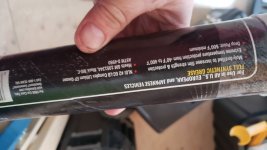Couple things while I wait for it to get daylight out--I can unhook under medium pressure, such as the empty loader lifted off the ground several inches or several feet. No problem. As a matter of fact, it unplugs even easier, as the extra pressure helps "push" the hose out of the coupler. The problem arises when trying to plug the hose back in, because I (and most people) aren't tough enough to depress the sealing balls (pointed tips, in my case) that keep oil from dripping out of the disconnected components.
My tractor has a set of (4) couplers located on the right side, just forward of the cab, about knee high, in a perfect position to receive all the mud, snow, ice and whatever else the front tire can throw onto it.
I also have one set on the rear of the tractor. They, also, are the "just give it a hard, straight yank " type.
I have seen what's called "flat face" couplings that supposedly hook and unhook under pressure. I've seen them on skid steers, mostly. Myself, I've never been able to hook and unhook them. Another fella can come along and plug them together just as easy as you plug a lamp into the wall.
I doubt I could call mine flat face, because they aren't. They look like the hydraulic couplings made for ages, with a male tip that has a self-sealing tip, a machined diameter to slide into the O ring inside the female part, and a groove to receive the detent balls that retain the tip into the female coupler body.
In case I'm all wrong about the OPs style of coupler, and they are the older, "retract the sleeve" type, I would say to first make sure the collar rotates. I've had these also, and they can become jammed up with dirt or rust. Rotating the collar breaks that stuff loose. Then, if pressurized air is available , blow out the junk and dirt, rotating the collar as you blow. Then perhaps he could move that collar. On older versions, the collar only moved one way, away from the male tip, just like an air hose coupler. Newer versions had the luxury of moving the collar either way to unlock the retaining balls. If the OP has this style and can't rotate the collar, it's pretty jammed up and that's where he will have to start. That's "IF" he has the moveable collar type.
